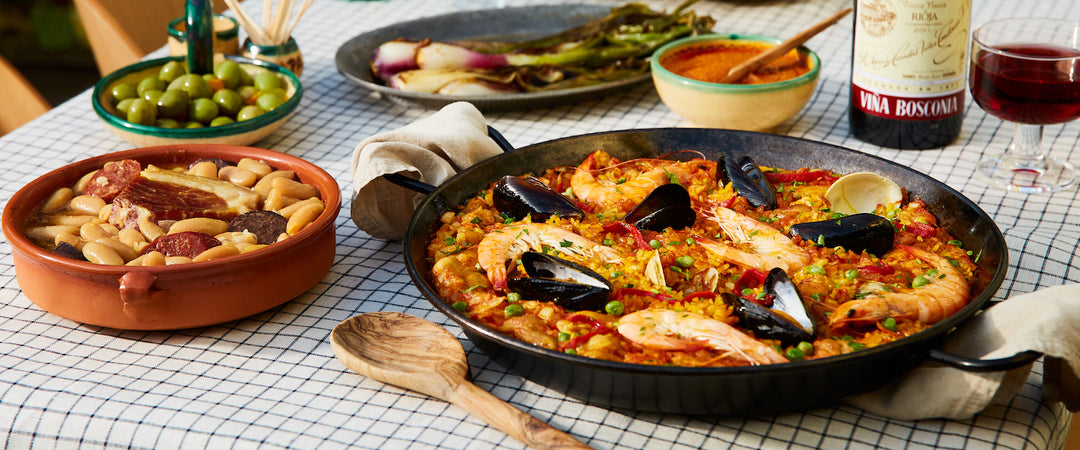October 2025 Crianza Club
 |
Bodegas Breca 2021 El Nacido Garnacha Calatayud Regular Price: $22.99
Club Price: $19.54
|
This time last year I was just returning from a stunningly educational trip with Jorge Ordonez's very eloquent and wine savvy son Victor. During this trip, I (along with other Northern and Southern California celeb wine vendors), got to visit more than 10 wineries and tasted over 100 wines. Every single winery was of course memorable, but the visit to Ordonez's 'own' winery of Bodegas Breca in the high country of Aragon somewhat felt like a spot visit to the heart of Spanish wine. Bold statement, but true.

All of the wines made at this estate are various styles of pure Garnacha, and all of them capture what we felt standing in the vineyard and put it in bottles. And that, to me, is the essence of winemaking. Since we only put the wines on our shelves last year but never featured them in the wine club, we decided to feature the youthful and spritely El Nacido in the Crianza club. As a matter of fact, much of the October wine club is sprinkled with and a love letter to Garnacha.
We’re beginning this month’s Garnacha love-fest in Aragón, where the grape has its deepest roots. Few people have done more to bring Garnacha from Aragón to the world than Jorge Ordóñez. As one of the first exporters of Spanish wine to the U.S., he made it his mission to showcase the old vines and rugged landscapes of this region. His Bodegas Breca project in Calatayud is entirely devoted to Garnacha, and it produces a range of bottlings that reveal the grape’s many sides.
While the winery itself is already at a fairly high altitude, the drive from the winery to the vineyards takes one even higher, through almond groves, sunflower fields, and yes, fields of solar panels (the subject of some controversy locally over whether the fields of panels represent the region's contribution to Spain's energy independence and climate harm reduction, or whether these horrible things are the end of a traditional way of life). Either way, the presence of all three (almonds, sunflowers, solar panels) makes it clear that one resource here is abundant: sunshine. And that sunshine is what powers the Garnacha of the region. Upon arrival in the 25 degree up-sloping vineyard, we were greeted by the by both the bold mid morning sun and the intense and pleasant smell of wild thyme. The old bush vines, full of almost ripe fruit, look down happily over incredible vistas of the whole valley. The vineyards here are composed of a wild mix of slate and quartz, with bush-trained vines some 60–100 years old. The soils are poor, rocky, and unforgiving—perfect conditions for Garnacha, which thrives under stress. Summers are hot, nights are cool, and the altitude keeps the wines vibrant despite the intensity of the sun. Some parts of the vineyard are actual soil, others piles of rock shards. Wild Thyme grows everywhere, the sun shines brightly, and the vistas go on forever. While there is probably much more science to be done to understand what turns the soil and climate into flavors, the simplest and oldest adage is that happy vines produce great wine. And with vistas like these below, wouldn't you produce great grapes, too?



At Breca, the focus is on giving voice to these old vines. Some wines lean toward richness and dark fruit, almost reminiscent of Zinfandel. But El Nacido shows another face of Calatayud Garnacha. Lighter on its feet, juicier, fresher, yet still marked by the herbaceous notes and concentration that are signatures of the region. It’s a wine that carries the stamp of Aragón while opening the door to Garnacha’s versatility. It also may be indicative of a generational change in the Ordonez family business. Jorge, old school as he is, loves himself a big, juicy, 15% red. His son understand the nuances of and possibilities in expanding that style palette to include fresher, lighter, more aloof styles. While we weren't told per se that Victor (and his equally adept sister's) decision making is involved, I suspect so. Last but not least, as you can see from the photo below, these old vineyard, like many of the older vineyards in Spain, contain a fair amount of random white grapes, which are simply picked and co-fermented with the reds. A great way to introduce levity, and as is now understood scientifically, the compounds in the white skins help extract flavor and color from the reds.

While I love the wine and could describe it well, I will leave the sensory analysis to Jeb Dunnuck, who gave it 94 points: "“The 2022 Breca El Nacido comes from higher elevation vineyards and is just about all Garnacha, co-fermented with a kiss of white varieties, that's raised in a mix of tank and barrel. Ripe black cherries, black raspberries, peppery herbs, crushed stone, and violet notes all dene the aromatics, and it's medium to full-bodied, with a pure, layered mouthfeel, ripe tannins, and a rare mix of richness and freshness.” We feel this wine is a great mix of bold and light, perfect for the mixed bag that this bay area October seems to be. Bold enough for a cooler day and a lamb-based dish, and light enough to be served lightly chilled on the last hot days of the year. Lamb chops on the grill or a thick slice of lomo Iberico (cured pork loin) are this wine's best culinary friend.
 
|
Bodegas Luzon Regular Price: $22.99
Club Price: $19.54
|
Deep in the southeast of the Iberian peninsula, quietly lies a hidden gem of the wine world: Jumilla. No surprise if you haven't heard of it, this is likely one of your wine-nerd friend’s secret favorites. The star grape of the region is Monastrell, also known as Mataro and Mourvédre. It’s an inky and bold grape, often accompanied by dark fruit, slate, leather and savory herb flavors.
Bodegas Luzon’s story actually begins a world away in the Philippines. Commander Don José de Molina returns home from his duty under the Royal Armies and names his estate ‘Finca Luzon’ after the island where he was stationed. Winemaking at the estate continued under his children, who later inherited the estate in 1863. It stayed in the family, and winemaking slowly ceased production until 1980, when the estate was purchased by Don Juan José Martínez Abellán, who resumed winemaking activities.
The Altos de Luzon hails from their La Melera vineyard which sits 680 meters in elevation and consists of the loose, sandy limestone soil that Monastrell loves. Organically farmed and averaging 48 years of age, the vines produce grapes with deep concentration and robust skins.
Deep violet and ruby in color, the wine smells of blackberry, cassis, cherry, herbs and a touch of tapenade. On the palate, the ripe dark berry notes blossom as well as chocolate, espresso, toffee, and quintessential savory herbs and spices. The texture has fine, yet firm tannins, and the alcoholic weight warms the cheeks. This wine begs for stewed or braised red meats. Think ossobuco, beef bourguignon, or fabada stew!
Oh, and PS: besides us liking it, it's also gotten plenty of accolades to give it cred.




